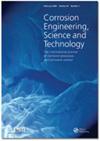Accelerated corrosion test and field test of steel and zinc coupons at buffer areas and cross passages in a mass rapid transit tunnel
IF 1.5
4区 材料科学
Q4 MATERIALS SCIENCE, MULTIDISCIPLINARY
Corrosion Engineering, Science and Technology
Pub Date : 2023-01-15
DOI:10.1080/1478422X.2022.2163335
引用次数: 1
Abstract
ABSTRACT A study has been conducted to measure the distribution of temperature, relative humidity and corrosivity due to uniform corrosion along the Mass Rapid Transit (MRT) North East Line (NEL) tunnel in Singapore. The corrosion rates of carbon steel 1010 and zinc coupons at the buffer areas of ten stations and five cross passages along the NEL were monitored over a period of one year. The median temperatures were between 31 and 36°C while the median relative humidity varied between 43 and 53%. At all exposure sites, the values of relative humidity corresponding to the 75th percentile values were below 60%, with very few data points registering above 80%. The cross passages showed a lower degree of fluctuations in the temperature and relative humidity compared to the buffer areas. The corrosivity levels showed some differences between exposure sites, but their values were generally low and could be categorised as C1 according to the ISO 9223:2012 categorisation. A set of procedures for an accelerated laboratory test to approximate the corrosion in the tunnel was also studied. The test procedures involved the exposure to a salt fog containing 0.12% Na2SO4 + 0.05% NaCl, followed by a drying phase and subsequent exposure to a constant temperature of 40°C and a constant relative humidity of 60%. It was found that after exposure for 80 h, the accelerated tests were able to generate the degree of corrosion observed in the most severe conditions in the field.大型捷运隧道缓冲带及交叉通道钢锌板加速腐蚀试验及现场试验
摘要对新加坡捷运(MRT)东北线(NEL)隧道进行了温度、相对湿度和腐蚀性均匀腐蚀分布的测量研究。在一年的时间里,对全国铁路沿线10个站点和5个交叉通道缓冲区碳钢1010和锌片的腐蚀速率进行了监测。气温中位数在31 ~ 36℃之间,相对湿度中位数在43 ~ 53%之间。在所有暴露点,第75百分位数对应的相对湿度值均低于60%,只有极少数数据点高于80%。与缓冲区相比,交叉通道的温度和相对湿度波动程度较低。不同暴露地点的腐蚀等级有所不同,但它们的值普遍较低,根据ISO 9223:2012的分类可以被归类为C1级。本文还研究了一套模拟隧道腐蚀的加速实验室试验程序。测试过程包括暴露于含有0.12% Na2SO4 + 0.05% NaCl的盐雾中,然后是干燥阶段,随后暴露于恒定温度40°C和恒定相对湿度60%的环境中。结果发现,在暴露80小时后,加速试验能够产生在现场最恶劣条件下观察到的腐蚀程度。
本文章由计算机程序翻译,如有差异,请以英文原文为准。
求助全文
约1分钟内获得全文
求助全文
来源期刊

Corrosion Engineering, Science and Technology
工程技术-材料科学:综合
CiteScore
3.20
自引率
5.60%
发文量
58
审稿时长
3.4 months
期刊介绍:
Corrosion Engineering, Science and Technology provides broad international coverage of research and practice in corrosion processes and corrosion control. Peer-reviewed contributions address all aspects of corrosion engineering and corrosion science; there is strong emphasis on effective design and materials selection to combat corrosion and the journal carries failure case studies to further knowledge in these areas.
 求助内容:
求助内容: 应助结果提醒方式:
应助结果提醒方式:


